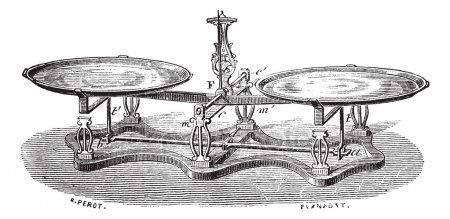The manipulated balance

- 1890
- 478
- Austin Stokes
 The Money of the East, coined in sizes and variable weights to allow travelers to be deceived, is too complex for our mathematicians, so that by describing trade between oriental we will simplify things speaking in dollars and cents.
The Money of the East, coined in sizes and variable weights to allow travelers to be deceived, is too complex for our mathematicians, so that by describing trade between oriental we will simplify things speaking in dollars and cents.
Camel hair, which is used in the preparation of shares and expensive carpets, is gathered by what is called ordinary people and sold through a commissioner, in large or small amounts, to merchants. To ensure impartiality, the commissioner never buys for himself but, upon receiving a purchase order, looks for someone to sell, and charges two percent of the transaction. However, manipulating the balance, he always manages to increase its benefits through deception, especially if the client is inexperienced enough to deposit confidence in his word or in his pious exclamations.
I take the opportunity to direct attention to a beautiful riddle related to the transaction that illustrates the simplicity of methods. Upon receiving a camel -hair shipment, the commissioner placed it on the short arm of his balance, as well as to gain one more ounce for pound, but when he sold it he changed the dishes to deliver an ounce less for each pound, and thus won $ 25 Thanks to its fraud.
(Remember that a pound is 16 ounces). It seems to be, and it really is a very simple problem, with sufficient clear data. However, it will require the intelligence of an expert accountant to calculate the correct answer to the question: How much did the commission for the merchandise?
SolutionIf the intermediary weighed the goods at one more ounce per pound, he got 17 per pound. When he sold them at the rate of an ounce less per pound, he gave 15 ounces for each pound, and obtained 2 ounces of more. If these 2 ounces were sold at the same price, to win $ 25 through deception, it is evident that 2 ounces represent 2/15 parts of what he paid for everything and charged for the 15 ounces. If 1/15 ok $ 12.50, 15/15 or the total, it would be $ 187.50 that, if the commission did not exist, it would be the figure paid for the merchandise.
However, we discovered that he received 2% of the seller, $ 3.75, and $ 4.25 from the buyer, for intermediation, which gave him $ 8 in addition to the $ 25 he had won with his fraud.
Now, if it had been honest, I would have paid for 17 ounces which, to be exact, would have given a total of $ 199,21875. Its percentage to buy and sell would then have been $ 7,96875, so that with its deception it achieved an additional 3 cents and 1/8. As the story says that exactly $ 25 with fraud, we must reduce the price of $ 187.50 so that its two frauds produce exactly $ 25.
Now, as 3 cents and 1/8 is exactly 1/801 of $ 25,03125, we must subtract $ 187.50 its 1/801 part, which will give $ 187.27, so that the intermediary will do, with its fraud, The sum of $ 25 and 0.0006 cents. For those who wish to be very exact, I would say that the seller is paid $ 187,2659176029973125 less the 2% commission of $ 3,745.

